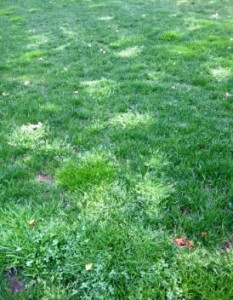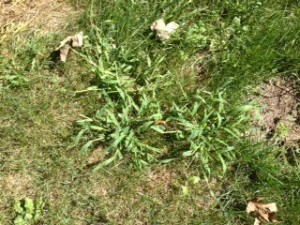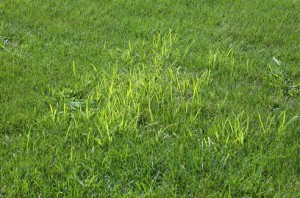One of the biggest problem weeds we are seeing is the Crabgrass Imposter, Paspalum. Paspalum, as you can see from the picture looks very much like Crabgrass but does not react the same as crabgrass when treated. There is no pre-emergent for Paspalum. As our customer’s know, The Greenskeeper does 2 applications of pre-emergent crabgrass control. We found several years ago under certain conditions, (like the sporadic yet very heavy rains) the barrier that pre-emergents form can be washed away. A second application assures that the barrier is in place through the entire summer. Paspalum, because it proliferates by both seeds and short rhizomes can not be controlled by a pre-emergent. The difficulty in eradicating this weed is that products used to treat these weeds should not be applied when a lawn is experiencing heat or drought stress as it can damage turf grass. And you guessed it, Paspalum thrives in those conditions.
The next weed we are seeing a great deal of again is Nutsedge. Like Paspalum, Nutsedge is a rhizome. While it does come up in established lawns, we
often see it in newer lawns or lawns where new loam has been brought in. Suddenly, it takes off like wildfire and the entire neighborhood is infected. Nutsedge does not respond to broadleaf weed control and a special product has to be used on this invasive weed. Like the products used to treat Paspalum, it is best to treat Nutsedge when lawns are healthy and not experiencing drought or heat stress. While there is no way to prevent weeds from infiltrating your yard, your Greenskeeper can not only treat weeds but improve the health of you lawn. A healthy lawn will rebound and fill in faster after a problematic season of weeds.
]]>
Annual blue grass gone to seed.
Mellow Yellow??
No thank you! Lawns were meant to be green and lush. This spring, things are ahead of schedule. Here is what we are seeing:
Annual Blue Grass: That fuzzy yellow grass in the lawn is annual blue grass going to seed. It’s a natural occurrence and depending on how much of this grass you have in your turf, your lawn might look like a patchwork quilt. The good news, is the seed will grow out and the blue grass will become a lush green and blend in with the rest of your lawn. There is no need to do anything but just watch it grow.
Drought Stress: This is usually a problem we see in summer, not early spring. But the lack of rain (until today) and record warmth have put many lawns into drought stress. If this weather pattern continues, watering is a must. At least 3 days per week (every other day is best) for 30-40 minutes is all it takes to keep your grass hydrated. Fortunately, the rain we are getting on 4/23 and cool temps predicted for the rest of the week should help many lawns bounce back.
Weeds: Many broad leaf weeds did not die off during this winter that wasn’t and we are seeing more clover and dandelions than usual. For those still waiting for their fertilizer application, that’s not a bad thing. Your Greenskeeper will be able to take care of those visible broad leaf weeds, making them not so fond memory by Memorial Day.
To our valued customers, if your Greenskeeper has not been out yet, we are on our way. As you know, the first round of treatment starts April 1st and goes right through mid May. If you have any questions about your lawn prior to our first visit, please do not hesitate to call or email. If you aren’t a Greenskeeper customer, we’d love to hear from you too. The Greenskeeper Lawn, Tree & Shrub is always happy to provide a free, no obligation lawn analysis.
Why hire an ordinary lawn care company when you can have a Greenskeeper?
]]>

